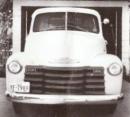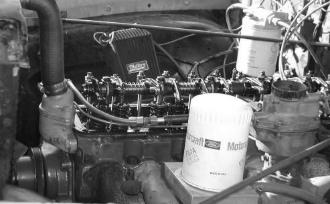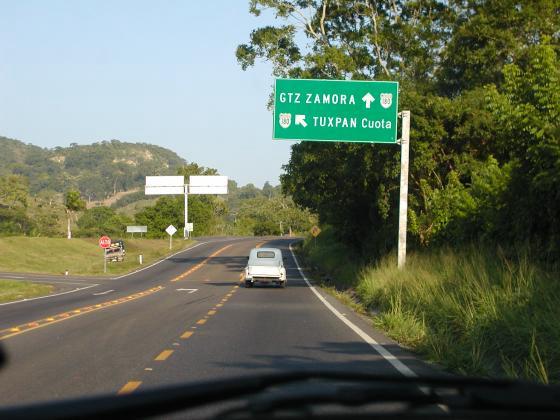Just before Christmas Larilla asked, “Is that truck ready yet? I’ve been asking this question since August.”
After giving the matter a little thought, I replied, “It’s about as ready as it can be for a 1000 miles through the mountain vastness of Mexico.”
“Okay, then,” she said, “We’ll leave for Veracruz in the morning.”

You might wonder why a respectable middle-aged lady and an old geezer bundled themselves into a 1950 Chevrolet pickup and set out at two o’clock on a cold Texas morning for a trip to southern Mexico. I’m still not sure why, although the putative reason was to deliver the truck to Larilla’s brother, Mark, who lives in Veracruz. It would be his Christmas present.
The truck had been in the family since anyone could remember, passed around from kid to kid like a case of measles. Over the years it was modernized, if that’s the right term, with a 1954 235 engine, a Saginaw four-speed transmission, new leaf springs and 12-volt electrics. When the old girl showed up last summer, I replaced the water pump, alternator, rebuilt the transmission, had the gas tank cleaned, went through the engine and did a hundred other things. In view of the mountains ahead, the proper tie-rod ends and a two-circuit master cylinder were fitted. But much was left undone when we set out that morning.
Larilla complained of the cold and wondered why I had not bothered to connect the heater. I explained that engine heat, filtering through the holes in the firewall, was sufficient to take the chill off. Anyway, we wouldn’t be needing a heater once we got into Mexico. And, come dawn, we wouldn’t miss the dash lights or fiddle anymore with the low beams that glowed orange like jack o’ lanterns. What was more bothersome was the way the slightest road camber sent the truck hurtling for the shoulder. A mechanic had warned me about the kingpins, when it was too late to do anything about them.
The speedometer didn’t work, so I drove with a shop tach clipped to the dashboard and illuminated by a flashlight. With practice it was possible to hold the rpm at a steady 3200, a speed that Larilla computed to be 35 mph. Our leisurely progress infuriated truckers on I-10, who blasted by, horns shifting frequency with the Doppler effect.
By noon we were making the long transverse of the King Ranch, which has to be one of the most desolate landscapes in the world. Flat, arid and menacing, as if the violent history of the place were still hovering about. We crossed the border at McAllen and, after a two-hour hassle with Mexican customs over the vehicle title, got through to the other side.
The parking lot at customs was filled with battered cars with a second, even more wrecked vehicle in tow. Drivers, known as caravaneros were performing major repairs as they waited for clearance to proceed into Mexico. From there, they would go on to Guatemala and Honduras, where the gringo discards would be reworked and sold.
Larilla’s husband Jim and her brother Mark had agreed to meet us in Tampico, some 200 miles to the south. That had seemed like a good plan, except that Tampico kept moving around. In late afternoon, I saw a sign announcing that Tampico was 245 kilometers ahead. Four hours later, another sign indicated that the elusive city was now 251 kilometers distant.
With darkness, we found our way and began the long climb to the mountain city. The two-lane road, 15 ft wide at best, seemed to narrow as the altitude increased. Actually, the dimensions did not change, but the penalty for running off the edge of the asphalt increased. What had been rocks and stubble was now transformed into deep mountain ravines. The Chevy kept darting to the right as if it had a death wish. Approaching traffic doused us with their high beams, giant trucks pulling double trailers edged into our lane, and buses, the most feared vehicles on Mexican roads, nibbled at our rear bumper before squeaking by. The tach now registered 4700 rpm, which was a fast as I dared go.
The ascent continued for several hours. Finally we stopped at an all-night coffee shop and taco shop and took the opportunity to check the oil. A single drop of oil clung to the end of the dipstick. I told Larilla that we might not make it after all.
Attempts to phone Jim were fruitless (the Mexican telephone system is by no means universal), so we added four quarts to the crankcase and continued on. By that time, most of the truck drivers had bedded down for the night, slinging hammocks under their trailers. And the remainder of the road was relatively flat.
A few hours later we came to the stop light at the intersection between highways 81, 180 and 80. All traffic from the north into Tampico must pass through that light. We pulled into a gas station and checked the oil. It was full! I never did figure out where the oil had gone during that previous check, but subsequently the engine used no more oil, even when pushed to 4400 rpm and beyond. A small crowd gathered as we gassed up and one young man correctly identified the engine as a “dos triente cinco.” That it is, buddy, a 235 block, solid as the day it was poured.
As we were leaving town, one of the passing caravaneros slowed and yelled, “A fat boy was looking for you!” That description would fit Jim or Mark, or come to think of it, me. Further questioning revealed that two gringos had been at the traffic light asking if anyone had seen us. They had just left.
The road became mountainous again and suddenly we plunged into the deepest, most opaque fog this side of the planet Venus. It was as if we followed a moving wall, eight feet ahead of us. There was no place to pull over – a shear drop-off on the right and traffic coming up fast behind.
The engine coughed, slowed and caught. Moisture getting to the ignition, probably. It happened again. If we lost the engine, I would coast to a stop and tell Larilla to get out and run back toward the oncoming cars, where she might get clear of the collision.
But whatever the problem was, it went away. The blessed old 235 sputtered and wheezed and settled down into her familiar roar.
By two o’clock that morning we were rolling along the streets of Tampico, not far from the hotel where Jim and Mark were to meet us. Blue strobe lights exploded in the mirror and a local cop pulled us over. Swerving was the offence. I tried to explain in my fractured Spanish that the steering was faulty, but he insisted on collecting a fine of 20 pesos, about $2. I only had a 100 peso bill and he took off with that, grinning like the thief he was.
A few minutes later we pulled into the hotel parking lot and turned off the engine. Larilla and I sat for awhile in silence. It had been a long and sometimes daunting 24 hours, but all that was behind us now. Nothing more could go wrong.
Larilla went inside and a few minutes later returned, fighting back tears. Jim and Mark were not there. They had been ejected from the hotel 15 minutes before. What, I wondered, could two grown men do to get themselves thrown out of the best hotel in Tampico?
We managed to get hold of them by telephone and ended the night in what was probably the second-best hotel in Tampico. The problem with the first hotel was Drydock, Jim’s misnamed Llasha Apso. On hearing that there was a dog in Jim’s room, the manager went up to investigate. Drydock responded by throwing up on the carpet. Earlier Drydock had endeared herself to the Mexican army by relieving herself at one of their check points.
Jim and Mark also had a hectic day. Beside themselves with worry, they drove to the highway intersection and waited six hours at the traffic light, questioning every caravanero who came through. According to Mark, caravaneros function as the eyes of God on Mexican roads. Nothing escapes their notice. And none of them had seen a wrecked or broken-down white truck. When the fog rolled in, Jim and Mark drove back to Tampico, confident that we had found a place to stop for the night.
 The next morning, I adjusted the valves in the hotel parking lot – the valves for No. 1 cylinder had developed a quarter-inch of clearance – and ate a leisurely breakfast. For the first hour or so on the road, we played tag with a double-trailered Pepsi Cola truck, pictured here. A sign on the back of truck said: “PRECAUCION DOBLE SEMIREMOLQUE,” that is, two semi-trailers.
The next morning, I adjusted the valves in the hotel parking lot – the valves for No. 1 cylinder had developed a quarter-inch of clearance – and ate a leisurely breakfast. For the first hour or so on the road, we played tag with a double-trailered Pepsi Cola truck, pictured here. A sign on the back of truck said: “PRECAUCION DOBLE SEMIREMOLQUE,” that is, two semi-trailers.
Traffic came to a halt at the bottom of a slight hill. A little green and while Nissan taxi had rear-ended a bus in the on-coming lane. An ambulance pulled up in the now empty lane in front of the bus. Motorists helped the taxi driver into the back of the ambulance. He did not seem badly hurt.
Suddenly our old friend, the Pepsi Cola truck, came rolling down the incline and smashed into the ambulance. It was not going fast, but soda pop is heavy. Much argument followed: the ambulance driver blaming the trucker and the trucker pointing to his still smoking brakes.
Meanwhile, the taxi driver, still in the ambulance, was ignored. As Mark said, “That guy is having one hell of a day.” I expected Mel Brooks to pop up at any minute.
It was already dark when we approached Veracruz. A few miles outside of town the engine quit at a traffic light. Gasoline poured out of the carburetor and sizzled into steam as it hit the exhaust manifold. As I stood staring into the open hood, one of the giant autobuses squeezed by, snorting and wheezing, six inches from my rear end. Jim, in his truck behind us, took the opportunity to holler, “Welcome to Mexico!”
A quick teardown of the carburetor dislodged the speck of dirt under the inlet needle. The engine came back into life and an hour later we were in Mark’s house. The brave lady, old man and almost equally old Chevy had made it.
